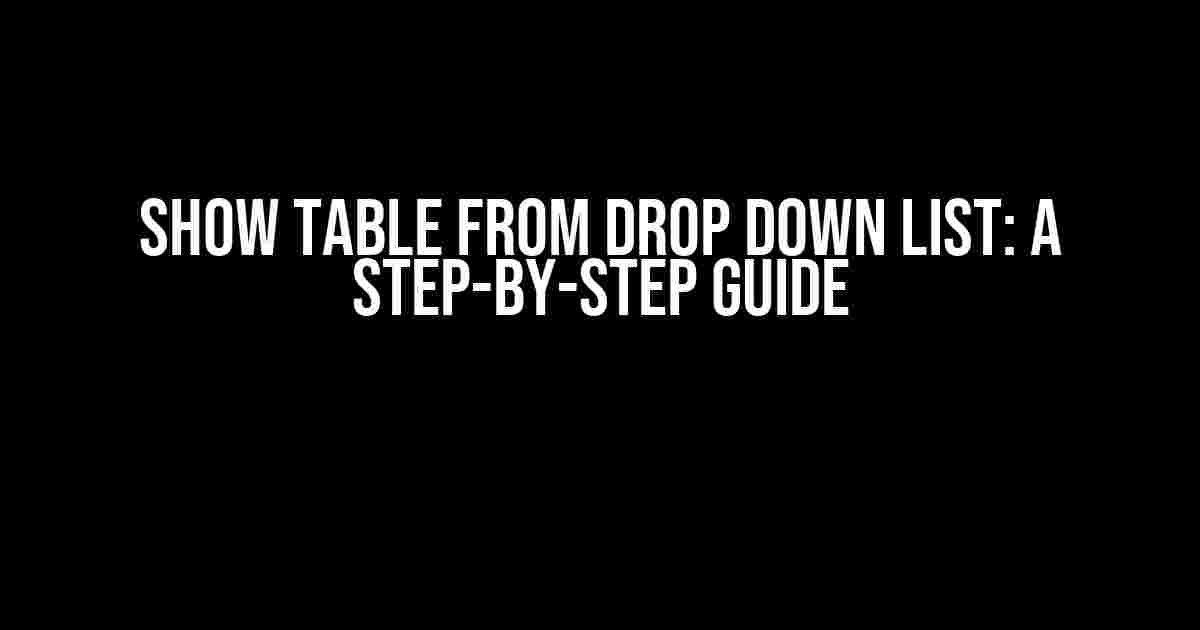Are you tired of cluttered web pages and wanting to add some interactivity to your website? Look no further! In this article, we’ll show you how to create a dynamic table that appears based on a user’s selection from a drop-down list. Sounds cool, right? Let’s dive in!
What You’ll Need
To follow along, you’ll need some basic knowledge of HTML, CSS, and JavaScript. Don’t worry if you’re new to these technologies – we’ll break it down step by step. You’ll also need a text editor or IDE to write your code.
Step 1: Create the Drop-Down List
The first step is to create the drop-down list that will trigger the table display. We’ll use HTML to create the select element:
<select id="mySelect"> <option value="" selected>Select an option</option> <option value="table1">Table 1</option> <option value="table2">Table 2</option> <option value="table3">Table 3</option> </select>
In this example, we’ve created a select element with an ID of “mySelect” and four options, including a default “Select an option” choice. You can customize the options to fit your specific needs.
Step 2: Create the Tables
Next, we’ll create the tables that will be displayed based on the user’s selection. We’ll use HTML again to create three separate tables:
<table id="table1"> <tr><th>Column 1</th><th>Column 2</th></tr> <tr><td>Cell 1</td><td>Cell 2</td></tr> <tr><td>Cell 3</td><td>Cell 4</td></tr> </table> <table id="table2"> <tr><th>Column A</th><th>Column B</th></tr> <tr><td>Cell 5</td><td>Cell 6</td></tr> <tr><td>Cell 7</td><td>Cell 8</td></tr> </table> <table id="table3"> <tr><th>Column X</th><th>Column Y</th></tr> <tr><td>Cell 9</td><td>Cell 10</td></tr> <tr><td>Cell 11</td><td>Cell 12</td></tr> </table>
We’ve created three tables with IDs of “table1”, “table2”, and “table3”, each with unique column headings and cell values. You can customize the tables to fit your specific needs.
Step 3: Add JavaScript
Now it’s time to add the magic that will make the tables appear and disappear based on the user’s selection. We’ll use JavaScript to achieve this:
<script>
const select = document.getElementById("mySelect");
const tables = document.querySelectorAll("table");
select.addEventListener("change", () => {
const selectedValue = select.value;
tables.forEach((table) => {
if (table.id === selectedValue) {
table.style.display = "block";
} else {
table.style.display = "none";
}
});
});
</script>
In this code, we first get references to the select element and all the table elements on the page. We then add an event listener to the select element that listens for changes to the selected value. When a change occurs, we loop through all the tables and check if the table’s ID matches the selected value. If it does, we set the table’s display property to “block”, making it visible. If it doesn’t, we set the display property to “none”, hiding the table.
Tips and Variations
Now that you’ve got the basic functionality working, here are some tips and variations to take your implementation to the next level:
- Use CSS to style your tables and drop-down list: Add some CSS flair to make your tables and drop-down list look visually appealing. You can customize the fonts, colors, and layouts to fit your website’s design.
- Add more tables and options: Want to display more tables based on user selection? Simply add more options to the drop-down list and create corresponding tables with unique IDs.
- Use this technique for other elements: Don’t just stop at tables! You can use this technique to show and hide any HTML element based on user selection, such as divs, images, or even entire sections of your website.
- Make it responsive: Ensure that your implementation works well on different devices and screen sizes by adding responsive design principles to your CSS.
- Add animations and transitions: Want to make the table appear and disappear with a smooth animation? Use CSS transitions or JavaScript animation libraries like AnimeJS or Velocity.js to add some visual flair.
Common Issues and Troubleshooting
Having trouble getting the code to work? Here are some common issues and troubleshooting tips:
- Tables not appearing or disappearing: Check that the table IDs match the values in the drop-down list options. Make sure there are no typos or inconsistencies.
- JavaScript errors: Check the console log for any JavaScript errors. Ensure that the script tag is placed after the HTML elements it references.
- Tables not styling correctly: Check that your CSS is targeting the correct table elements and that there are no conflicting styles.
- Drop-down list not functioning correctly: Check that the select element is correctly referencing the JavaScript code and that the event listener is attached correctly.
Conclusion
And there you have it! With these step-by-step instructions and a bit of creativity, you can create a dynamic table that appears based on a user’s selection from a drop-down list. Remember to customize the code to fit your specific needs and don’t hesitate to reach out if you encounter any issues. Happy coding!
By following this guide, you should now have a solid understanding of how to show a table from a drop-down list. Experiment with different variations and techniques to take your implementation to the next level. Happy coding, and we’ll see you in the next article!
| Keyword | Article |
|---|---|
| Show Table From Drop Down List | This article! |
Here are 5 Questions and Answers about “Show Table From Drop Down List” with a creative voice and tone:
Frequently Asked Question
Want to know more about Show Table From Drop Down List? We’ve got you covered! Here are some frequently asked questions and answers to get you started.
How does Show Table From Drop Down List work?
Show Table From Drop Down List is a feature that allows you to dynamically display a table based on a selection from a drop-down list. It’s like magic! You create a table with multiple sheets, link it to a drop-down list, and voilà! The table updates automatically when you select a new option.
What are the benefits of using Show Table From Drop Down List?
With Show Table From Drop Down List, you can easily analyze and visualize different sets of data without having to create multiple tables. It’s perfect for comparing data, tracking changes, and making informed decisions. Plus, it’s a great way to declutter your dashboard and reduce information overload!
How do I create a table with multiple sheets?
Easy peasy! To create a table with multiple sheets, simply go to your table settings, click on the “Add Sheet” button, and follow the prompts. You can add as many sheets as you need, and even rename them to make it easy to identify the data.
Can I customize the look and feel of my table?
Of course! You can customize the look and feel of your table to match your brand or personal style. From fonts to colors, you can adjust the settings to make it your own. Plus, you can even add conditional formatting to highlight important trends and patterns in your data.
Is Show Table From Drop Down List compatible with other features?
Yes! Show Table From Drop Down List is designed to work seamlessly with other features, such as filtering, sorting, and grouping. You can even use it in combination with other interactive features, like charts and maps, to create a powerful and dynamic dashboard.
I hope this helps! Let me know if you need anything else.




